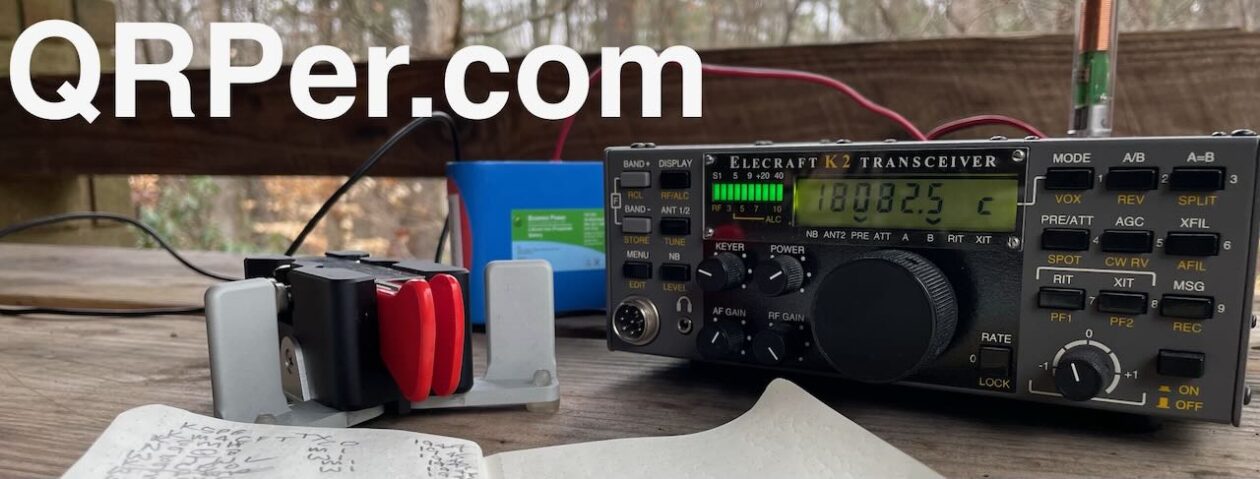 You might recall my previous announcement about the new N0SA SP4 POTA/SOTA Mini Morse Code Magnetic Paddle from CW Morse.
You might recall my previous announcement about the new N0SA SP4 POTA/SOTA Mini Morse Code Magnetic Paddle from CW Morse.
The first production run of these paddles sold out very quickly, but I just received the following message from CW Morse about the new paddles:
We’ve finally gotten caught up and will be shipping out Monday & Tuesday [Nov 21/22]! Also have a few more in stock. Making another batch as well.
CW Morse sent me a set of these paddles to evaluate at no charge to me (keep in mind, they’re both a sponsor and affiliate of QRPer.com) and I got a chance to use them Thursday afternoon.
In short?
I love these paddles!
 In fact, I think these may become my preferred compact paddles.
In fact, I think these may become my preferred compact paddles.
I like the size of the finger pieces/pads. They’re large for such a tiny paddle, which I believe gives them a solid feel while keying. I prefer a larger contact surface area as opposed to thin finger pieces.
The response is very precise, too, and the action can be adjusted by a supplied Allen wrench.
I agree with a few readers who’ve already received their paddles and noted that the carbon fiber reinforced PETG material make the key grippy and very easy to hold.
The size and design is very similar to the SOTA paddle N0SA sold out of last year in a matter of a few hours.
Bonus POTA Activation!
 Thursday afternoon, my daughters attended a two hour meeting not even a stone’s throw from the Blue Ridge Parkway. I had *just* taken delivery of the new N0SA paddles, so grabbed the shipping box from CW Morse, my new-to-me Elecraft K2/10 (more on that later!), and my PackTenna Random Wire antenna.
Thursday afternoon, my daughters attended a two hour meeting not even a stone’s throw from the Blue Ridge Parkway. I had *just* taken delivery of the new N0SA paddles, so grabbed the shipping box from CW Morse, my new-to-me Elecraft K2/10 (more on that later!), and my PackTenna Random Wire antenna.
I only discovered that my daughters’ meeting was so close to the parkway about 10 minutes before leaving the QTH. This was one of those bonus activations that deserved a little happy dance, especially since I could spend a good 1.5 hours on the air–a proper luxury for this busy father!
I’ll post a full field report and activation video in a couple of weeks, but in a nutshell, 30 meters was on fire. I’d planned to work 20, 30, and 40 meters (to test the K2’s internal ATU) but 30M was so dang busy, I never had time to QSY.
I had not put the K2/10 on the air yet, so all of the settings were default and it had been a few years since I used a K2, so had to re-familiarize myself with the settings. Thirty meters was so consistently busy, I didn’t have a breather to tinker with the settings.
 The new N0SA SP4 paddles worked flawlessly.
The new N0SA SP4 paddles worked flawlessly.
I expected nothing less from an N0SA design, but still–the feel and action is superb.
I think this paddle may become the new benchmark for where price and quality meet.
I feel like CW Morse could be charging $112.95 instead of $82.95 for these and I would still be very pleased with that price. I’m glad they’re not, though, because sub-$100 pricing does give new CW ops an affordable quality mini paddle option.
Based on so many reader recommendations, I purchased a BaMaKeY TP-III paddle recently. It’s also a wonderful paddle, but cost me 157.25 Euro which is nearly twice the price of the SP4 paddles. While I think the TP-III paddles are brilliant (and I’ll soon post a review) I actually prefer the N0SA SP4 paddles (note that this is my own personal preference–both are amazing keys). I prefer the SP4’s larger finger pieces.

The great thing about CW Morse is that they have the capacity to handle customer demand of the SP4 paddles–this is something N0SA couldn’t do as a one-man show. I think CW Morse also has economies of scale working in their favor and, no doubt, this is how they continue to be the market leader in terms of quality for price.
If you’ve been looking for quality mini paddles for your compact field kit or shack, look no further. These are a no-brainer. You’ll love them.
Click here to check out the new N0SA SP4 SOTA/POTA paddles at CW Morse.


































